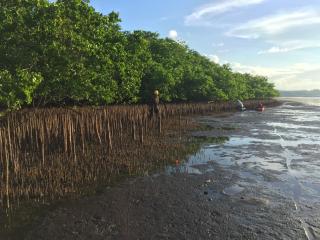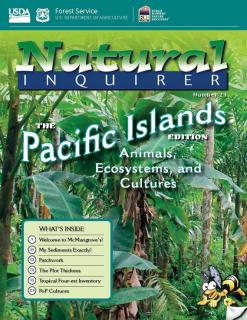Natural Inquirer explores the tropics for Pacific Islands Edition

WASHINGTON, DC—The biodiversity hotspots of the Federated States of Micronesia and Polynesia set the stage for the Natural Inquirer’s newest journal, The Pacific Islands Edition: Animals, Ecosystems and Cultures.
Designed for learners from middle school to adulthood, Natural Inquirer journals — which you can order for free —translate science into accessible language and provide background information, glossaries, reflection questions, maps, and web connections to clarify difficult concepts. “FACTivities” accompanying each article engage readers in hands-on experiences.
Throughout The Pacific Islands Edition, readers enter tropical mangrove forests where scientists track carbon cycles and investigate rising sea levels.
“Every time I enter a mangrove, it is like entering another world,” says Pacific Southwest Research Station ecologist Dr. Richard Mackenzie. “I feel like I am entering the Dagobah Swamp in the movie ‘Star Wars’ and almost expect to run into Yoda.”
Readers will also journey to American Samoa to learn whether removing invasive trees improves landscape health.
“My favorite science experience was undoubtedly working on the research described here in this journal, in the amazing rainforests of American Samoa,” says Pacific Southwest Research Station ecologist Dr. Flint Hughes. “The results of our research and community involvement provided educational and employment opportunities for the youth of American Samoa.”
Jaunts to Micronesia, Guam, and the Republic of the Marshall Islands introduce readers to forest inventory and analysis tools.
“Monitoring mangrove forests is uniquely challenging because it requires moving through a tight web of aboveground root systems,” says Pacific Northwest Research Station biological scientist Ashley Lehman. “Many mangrove forests have a maze of channels that flood with the incoming tides. Boating through this watery channel maze is both fun and challenging!”
Lastly, readers consume some PoP culture — that is, People of the Pacific culture! Indigenous knowledge of ecosystems help us better solve problems and is a key component of the future of the Forest Service.
Natural Inquirer journals and products provide formal and informal learning opportunities. Teachers can use them to guide learning — but so can parents, guardians, afterschool care providers, youth group leaders, and others. National Forest System offices, Research Stations, and any other Forest Service institution can also order them to better inform visitors of the science helping us care for the land and serve people.
Download or order copies of the Pacific Islands Edition today!

